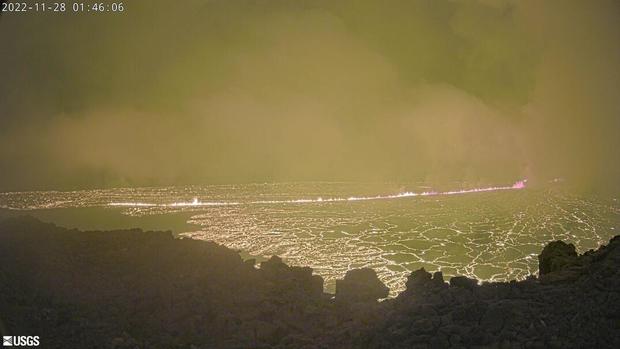Hawaii's Mauna Loa, the world's largest active volcano, erupting for first time in almost 40 years
Hawaii's Mauna Loa, the world's largest active volcano, started erupting Sunday night and lava was flowing from its summit by Monday morning, the U.S. Geological Survey said. The lava wasn't expected to threaten populated areas, officials said.
"Lava flows are not threatening any downslope communities and all indications are that the eruption will remain in the Northeast Rift Zone," the USGS said in a statement.
At a Monday afternoon press conference, Hawaii Volcano Observatory Scientist in Charge Ken Hon said officials don't expect the lava flow to reach the Southeast Rift Zone, where there are more inhabitants.
"As far as we know, in any historic precedence that there has never been an eruption of Mauna Loa that activated both rift zones at the same time or during the same eruption," Han said. "So we presume at this point that all of the future activity is gonna be on the Northeast Rift Zone and not on the Southeast Rift Zone. So those residents in that area do not have to worry about lava flows."
Mauna Loa has erupted 33 times since 1843, according to the USGS. It last erupted in 1984, when lava spilled down its slopes and came within 4.5 miles of Hilo.
Hon said the lava flow is very similar to the lava flow from the 1984 eruption and could potentially threaten populated areas around Hilo
"We're looking for somewhere around a week before we expect lava to get anywhere near that direction," he said. "We're hoping that it will parallel the 1984 eruption in becoming more viscous as times goes on and hitting flatter slopes that slow it down, and this actually prevented the lava from getting into Hilo."
He added that "only a couple of eruptions" have made it into the outskirts and reached Hilo.
"We're hoping that while this lava flow will be a big, spectacular event, it occupies a fairly small proportion of the island, and hopefully it will have relatively minor effects on the residents and visitors of the island," Hon said.
Still, the agency warned all residents on Hawaii Island who are "at risk from Mauna Loa lava flows" to "review preparedness and refer to Hawai'i County Civil Defense information for further guidance."
The early stages of an eruption can be dynamic, the agency warned, adding that "lava flows can change rapidly."
Residents were also warned volcanic gas, ash and thin glass fibers known as Pele's hair could be carried downwind.
The Hawaiian Volcano Observatory said it was "in close consultation with emergency management partners and will be monitoring the volcano closely to provide further updates on activity."
Major General Ken Hara, adjutant general for the State of Hawaii, Department of Defense, said Monday afternoon that the Hawaiin Emergency Management Agency had activated its emergency operation center at 1 a.m. Hara added that the Hawaii National Guard was on standby, although nobody had been activated as of 1:15 p.m. local time.
A satellite captured images of Sunday's eruption from space. The National Oceanic and Atmospheric Administration posted images of the heat signature and release of sulfur dioxide from the volcano.
In response to the eruption, Southwest Airlines canceled 10 interisland flights between Hilo, the island's biggest city, and Honolulu, the carrier told CBS News. Hawaiian Airlines said it was still operating on the island in Hilo and Kona while monitoring the eruption, and Untied Airlines reported no delays or cancellations Monday morning.
Mauna Loa's Hawaiian name means "long mountain," which is fitting as the huge mountain extends roughly 74 miles from its edge along Hawaii Island's southern coast, to the rim of its summit caldera, or crater, where the eruption began on Sunday evening.

